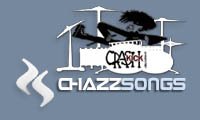A History of Pop Music
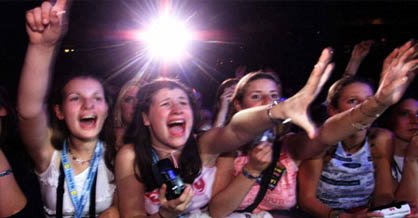
A History of Pop Music
by Geir Hongro
History is crowded with great pop music, but sadly a lot of it is often terribly
overlooked in Rock History books. This is meant as simply a chronological overview of
where to spot good melodic pop music, and it is then quite logical I start with the
early years:
The Pre-Beatles years:
In the years before Beatles we have to go back to Tin Pan Alley ( a name givin to
broadway show area of NYC, ) composers such as Cole Porter and George
Gerswin to find someone willing to go beyond stardard songwriting formulas and
write original and wonderful pop songs. In the early 50s Tin Pan Alley was generally
boring and it is understandable that something new was needed, which is why rock
broke through.
Pop in some way made a partial revenge in the late 50s with the Brill Building in
NYC now the centre. Songwriters such as Neil Sedaka wrote a couple of nice pop
song. Pop pundits may also find some musical interest in the recordings of Everly
Brothers, Roy Orbison and Buddy Holly. Still the best pop records
of the late 50s/early 60s were mainly done by black artists. Sam Cooke is one
of them. His songs such as "You Send Me" and "Only Sixteen" are great pop songs.
Later there were Drifters, an Atlantic soul vocal group that did some nice pop
songs. Singer Ben E. King did even better things on his own: You just HAVE to
like songs such as "Spanish Harlem" and "Stand By Me".
The Beatles and British Beat music

As probably a lot of pop pundits will agree
the story of good pop didn't start for real until the arrival of The Beatles.
I will go as far as say you are no real pop fan unless you have all - and I said
ALL of the Beatles albums. Beatles, simply stated, made pop better
than pop has ever been made before or since. Already from the start there was
something completely new about them, and songs such as "From Me To You", "She Loves
You" and "I Want To Hold You Hand" all changed the way pop was supposed to sound
forever. After that they became more and more adventurous.
"A Hard Day's Night" is one of the best pop albums ever made, with classics all
over. "Rubber Soul" is an exciting journey into folk rock terrotory while "Revolver"
and "Sgt. Pepper" are so adventurous and innovating while still keeping the ear for a
great pop tune". They said goodbye with "Abbey Road" which was again a huge pop
classic. Without Beatles there would have been no pop the way we know it today.
There also were other British beat groups starting in Liverpool at the same time
Beatles broke through. (The music was often called Merseybeat after the
Liverpool river) Gerry & The Pacemakers achieved great succes with partly
the same style. Billy J. Kramer & The Dakotas, Foursome and
Peter & Gordon were all given Lennon/McCartney songs to make their own
versions of. In fact someone who could donate songs like "Bad To Me" and "A World
Without Love" to other artists just had to have an almost eternal well of pop
classics to drink from.
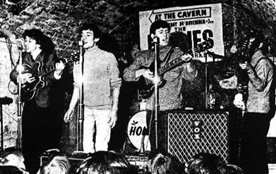 An often underrated 60s British Beat group is
The Hollies. OK, they didn't write their own songs until after the mid-60s,
but they were great singers and songs by writers such as Graham Goldman
sounded terrific when covered by Graham Nash, Allan Clarke et co. Recordings such as
"Bus Stop", "Yes I Will" and "He Ain't Heavy He's My Brother" all sound almost as
great as anything done by the Fab Four, and with "King Midas In Reverse" and the
entire "Butterfly" album they also proved they could be adventurous.
An often underrated 60s British Beat group is
The Hollies. OK, they didn't write their own songs until after the mid-60s,
but they were great singers and songs by writers such as Graham Goldman
sounded terrific when covered by Graham Nash, Allan Clarke et co. Recordings such as
"Bus Stop", "Yes I Will" and "He Ain't Heavy He's My Brother" all sound almost as
great as anything done by the Fab Four, and with "King Midas In Reverse" and the
entire "Butterfly" album they also proved they could be adventurous.
Other great British beat groups were The Kinks (Pure Pop pundits should steer
clear of their very earliest work though), Swinging black Jeans, Manfred
Mann, Freddie & The Dreamers, Dave Clark Five and The
Searchers, all did make some truly great pop stuff.
 Best of all, though, was the often
shamefully overlooked The Zombies (picture right). Their "Oddysey and Oracle"
album from 1968 is IMO one of the best pop albums ever made, but sadly the band had
already decided to break up by then as a result of poor sales and lack of public
acceptance. However a lot of musicians admired them a lot, and now it seems that
people are finally rediscovering their gems (not only "Oddysey and Oracle", but also
such wonderful early singles as "She's Not There" and "Tell Her No"..
Best of all, though, was the often
shamefully overlooked The Zombies (picture right). Their "Oddysey and Oracle"
album from 1968 is IMO one of the best pop albums ever made, but sadly the band had
already decided to break up by then as a result of poor sales and lack of public
acceptance. However a lot of musicians admired them a lot, and now it seems that
people are finally rediscovering their gems (not only "Oddysey and Oracle", but also
such wonderful early singles as "She's Not There" and "Tell Her No"..
Btw. Did you know that even Bee Gees started out making some wonderful melodic pop
singles?
The Revenge Of The US
The British invasion came as a shock to American artists, and it took some time to
recover. Still just a couple of years later America was once more potent to come up
with IMO the greatest period in American pop music ever!

The biggest name was, of course, Beach
Boys, who saw Beatles as their main rivals from the very start. Brian Wilson was
one of The Beatles' greatest admirers, and particularly he was struck by "Rubber
Soul", and set forward to make an even greater album. The result was "Pet Sounds",
definitely one of the greatest pop masterpieces of all time. Later that same year
(1966) they released "Good Vibrations" which was even greater a masterpiece.
But 1966 was not the beginning of Beach Boys. Even before that they were able to
come up with some pop songs most groups could only dream about making. Especially
their vocal harmonies were great, and they definitely inspired a lot of later
pop/power pop groups with those. The earliest real Beach Boys classic I can
think of is "Surfer Girl", which was a song way ahead of its time with its vocal
harmonies, and advanced chord changes.
The mid 60s also brought other great American music. Definitely defining their sound
about the same time as The Beatles were the Tamla Motown record company. With
artists such as Supremes, Temptations, The Four Tops, Smokey
Robinson & The Miracles, Stevie Wonder and Marvin Gaye. 60s
Motown music was great pop with great melodies, and it's only since the late 60s that
too many black artists have been busy with laying down a groove rather than writing a
strong tune.
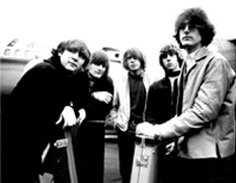
Still the defining thing about American pop music of the 60s was Folk Rock,
and the biggest folk rock name probably was The Byrds (picture left). Their
earliest stuff was a brave attempt at combining the best of the American folk
tradition with the best of the British Beat tradition. They also sang some wonderful
harmonies, and their version of Bob Dylan's "Mr. Tambourine Man" is easily the best
cover version ever done.
Other great folk rock bands of the 60s were The Mamas & The Papas(check
out the hamonies on "California Dreaming"!), The Turtles (underrated but
great) and Lovin' Spoonful. Some of Bob Dylan's work may also appeal to
pop fans.
The Psychedelic Years
 The psychedelic period was a funny time
when a lot of musical experiments were done. Again Beatles were forerunners, as most
of their 1967 ranks among the finest psychedelic music ever. "Sgt. Pepper's Lonely
Heart's Club Band" still wins surveys about the greatest albums ever.
The psychedelic period was a funny time
when a lot of musical experiments were done. Again Beatles were forerunners, as most
of their 1967 ranks among the finest psychedelic music ever. "Sgt. Pepper's Lonely
Heart's Club Band" still wins surveys about the greatest albums ever.
But psychedelic music was also initially highly melodic. Among other things this
meant that some of the hardest rock'n'roll bands suddenly produced some pop gems. An
example is The Rolling Stones, who made a couple of melodic pop albums in
1967. Also the newly formed Buffalo Springfield dropped their blacksiest music
to play some poppy and weird stuff.
Still the psychedelic period also brought the world some new names. Pink
Floyd and Traffic made some funny psychedelic singles just to turn into
more album oriented pop bands afterwards. Procul Harum and The Moody
blacks laid down the basement for what was to become known as progressive rock.
The psychedelic rock soon became more heavy and blacksy (the "psychedelic" and
"experimental" part often focused on new ways of treating guitar sound) and other
styles of music took over as great pop sources.
Bubblegum and Glam
While music became more and more adventurous during the other half of the 60s a
new sort of simple pop music was created for those who didn't want too adventurous
music. It was called Bubblegum and could most easily be described as nursery
rhymes put to a 60s rock/pop backing. Some of it was inspired by psychedelic rock
(some groups used sitar, for instance) while some of it was more similar to early 60s
music.
Some bubblegum acts were simply created by businnes people. One of those was The
Monkees. An American TV company was about to start a new TV series about a band,
and they needed some people to play the band members. The Monkees were given songs by
top songwriters, and some of their early stuff, like "Last Train To Clarksville" and
"I'm a Believer" definitely are quality pop classics. Later they lost their momentum
and turned into a MOR act.
Now a lot of other bubblegum acts turned up. With names like 1910 Fruitgum
Co., Amen Corner, Marmalade, Tommy James & The Shondells
and Ohio Express they came up with some cool pop tunes. Amen Corner were
famous for songs such as "Bend Me Shape Me" and "(If Paradise Is) Half As Nice". Old
Buddy Holly copycat Tommy Roe was possibly responsible for the best song of
all with "Dizzy".
 Some years later UK created its own answer
to Bubblegum. Glam Rock was harder edged and more rock'n'roll than Bubblegum
music, but the melodies were still nursery-rhyme-like. The name Glam Rock came from
how the artists appeared visually (with glam and glitter in their faces), but still
it also had musical components. A lot of Glam Rock is hitlist teen throwaway stuff,
but some of it actually was great pop. Slade, for instance, knew how to come
up with a great pop tune.
Some years later UK created its own answer
to Bubblegum. Glam Rock was harder edged and more rock'n'roll than Bubblegum
music, but the melodies were still nursery-rhyme-like. The name Glam Rock came from
how the artists appeared visually (with glam and glitter in their faces), but still
it also had musical components. A lot of Glam Rock is hitlist teen throwaway stuff,
but some of it actually was great pop. Slade, for instance, knew how to come
up with a great pop tune.
The most important artist of this age still is David Bowie (picture right).
While appearing as a strange angrogynous creature he actually made his best music
ever. His early 70s glam period was when he wrote songs such as "Starman", "Changes",
"Ziggy Stardust", "Life On Mars" and "Drive In Saturday" - all classics of British
pop music. Bowie also helped Mott The Hoople kick off their career, when he
wrote, and sung on, "All The Young Dudes".
Singer/songwriters
The early 70s also were the age of the singer/songwriter. Inspired partly by folk
they had a much simpler approach to music than the typical late 60s musicians. They
mainly wrote their own songs, thoughtful lyrics included, and they were strong on
melody and weak on backing stash. Singer/songwriters such as Carole King,
James Taylor, Paul Simon (initially with Art Garfunkel),
Carly Simon, Joni Mitchell and Don McLean all had their heyday
at this period.
While the singer/songwriter was generally a US phenomenom possibly the greatest of
them all was British. Elton John made some wonderful pop songs during the
early 70s, and noe one else have ever been able to write such beautiful piano based
ballads. Elton John was not completely a fully fledged singer/songwriter,
since Bernie Taupin wrote most of his lyrics, but his melodies (and Taupin's strong
words) are enough to make him a great artist from this period. Elton John's output
may have weakened, and today he is a boring MOR artist, but his early 70s records are
still worth checking out closer.
"Progressive Pop"The progressive rock age was a heavy period filled with
ambitious 20 minute works that don't really belong here. Still some of the
progrockers had an ear for a great melody, and especially Genesis are worth
checking out if you aren't afraid of ambitious music with more to it than just verse,
bridge and chorus. Especially "A Trick Of The Tail" and "Wind And Wuthering" are
filled with wonderful pop tunes.
More important, though, is the so-called "progressive pop" that came out of this period in UK music. Bands that were mainly pop bands, but still had lots of musical ambitions, suddenly emerged on the UK 70s scene. Examples were Supertramp, 10cc, Alan Parsons Project and Electric Light Orchestra. Canadian group Klaatu may also be mentioned here..

10cc (picture above) consisted of four experienced individuals. Graham Gouldman had been a songwriter with artists such as Hollies, Yardbirds and Herman's Hermits giving him hits, Eric Stewart had been a member of Mindbenders while Kevin Godley and Lol Creme had both been doing a lot of production work. Together they set forward to create a perfect sound, write some great tunes and sing the most wonderful vocal harmonies since The Beach Boys. Especially their mid-70s work was great. "I'm Not In Love" is a classic, but if you are into ambitious music album tracks such as "Don't Hang Up" and "Un Nuit a Paris" are even stronger.
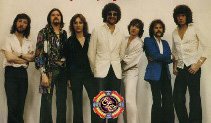 Electric Light Orchestra (picture
left) originally were based on UK 60s pop group The Move. Led by Jeff Lynne
and Roy Wood they intended to keep up where Beatles stopped around 1967, with string
based rock music inspired by "Strawberry Fields Forever" and "I Am The Walrus". Roy
Wood soon left to form throwaway glam band Wizzard and Jeff Lynne was left to
build up ELO (as they were usually) called on his own. He recruited several string
players plus keyboardist Richard Tandy (Keyboards were to become an important part of
their sound) and started writing wonderful melodic pop tunes with great backing
vocals. During the late 70s they were superstars, thanks to such wonderful albums as
"A New World Record", "Out Of The black" and "Discovery".
Electric Light Orchestra (picture
left) originally were based on UK 60s pop group The Move. Led by Jeff Lynne
and Roy Wood they intended to keep up where Beatles stopped around 1967, with string
based rock music inspired by "Strawberry Fields Forever" and "I Am The Walrus". Roy
Wood soon left to form throwaway glam band Wizzard and Jeff Lynne was left to
build up ELO (as they were usually) called on his own. He recruited several string
players plus keyboardist Richard Tandy (Keyboards were to become an important part of
their sound) and started writing wonderful melodic pop tunes with great backing
vocals. During the late 70s they were superstars, thanks to such wonderful albums as
"A New World Record", "Out Of The black" and "Discovery".Another band that partly belongs in this category are Queen. They were more of a rock'n'roll band than the others, but their songs, and their vocal arrangements, pointed in the pop direction. Queen were even more adventurous than 10cc when it came to backing vocals and "Bohemian Rhapsody" and the album where it was taken from; "A Night At The Opera" are true classics that every pop pundit should own. They continued making great pop until marvellous singer Freddy Mercury sadly died far too early from AIDS.
Power Pop
Already in the late 60s some people missed the great pop of the mid-60s. They
didn't want to be adventurous and experimental - they simply wanted to write great
pop songs. This is what led to Power Pop, which can easily be described as
"melodic rock'n'roll".
While Power Pop has mainly been an American phenomenon one of the early great Power
Pop groups was The British group Badfinger. They were on The Beatles'
recording label Apple, and musically they compared a lot to The Beatles, except they
had a harder edged sound. Songs such as "No Matter What" and "Come On And Get It" are
considered classics among most US pop pundits, as is "Without You", a song that was
actually more famous by Nilsson. Several central members of Badfinger tragically
suffered untimely deaths.
Another important early-70s Power Pop band was Raspberries. Led by Eric
Carmen they initially sounded a lot like The Beatles. The band didn't last very
long and Eric Carmen continued recording on his own. In 1977 the classically trained
Carmen had a major hit with "All By Myself", a hit that was partly built on a piece
by Rachmaninov.
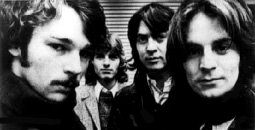 The third of the great early Power Pop
groups were Big Star (picture right). Led by pop legend Alex Chilton
they didn't sell that many records at once, but has since become legends and
important inspiration sources for almost any Power Pop band that was to follow.
"September Gurls" was their most famous song and has become a pop classic.
The third of the great early Power Pop
groups were Big Star (picture right). Led by pop legend Alex Chilton
they didn't sell that many records at once, but has since become legends and
important inspiration sources for almost any Power Pop band that was to follow.
"September Gurls" was their most famous song and has become a pop classic.
Also partly a Power Pop artist was Todd Rundgren. More occupied with trying
to find the perfect sound than the others Todd Rundgren made some wonderfully
produced melodic rock'n'roll, most well-known from his "Something/Anything" double
album.
As the 70s went more Power Pop groups appeared, most of them American. Among the
other important Power Pop names of the 70s were Flamin' Groovies, Cheap
Trick, 20/20 and The Knack. The latter group had a huge hit in the
US with "My Sharona" in 1979.
From Pubrock to New Wave
The UK Pubrock scene was in many ways quite similar to the US Power Pop
scene. The Pubrockers objected against the complexity of psychedelic and progressive
rock and wanted to make more simple melodic rock'n'roll. The leading bands among the
pubrockers were Ace and Brinsley Swarz, and those two bands were led by
respectively Paul Carrack and Nick Lowe, both of whom became important
figures in the UK 70s pop scene.
New Wave is often described as a more "sophisticated" version of punk, but
the fact is that besides an obvious reggae inspiration New Wave first and foremost
builds on the Pubrock heritage: Simple, melodic pop songs backed by power chords. The
before mentioned Lowe was one of the people behind what was to become the New Wave
sound, with songs such as "I Love The Sound Of Breaking Glass", "So It Goes", "Little
Hitler" and "Cruel To Be Kind".
Elvis Costello & The Attractions appeared on the scene in 1977 and has
since continued to provide the world with great pop music. Songs such as "Oliver's
Army", "Accidents Will Happen", "Clubland", the wonderful ballad "Shipbuilding" and
later gems such as "Veronica" and "The Other Side Of Summer" are all the sort of
songs that will delight any pop fan.
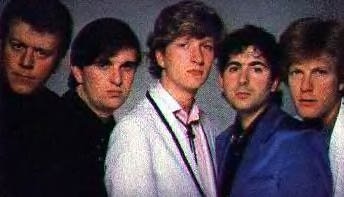 Anyway the New Wave group that more than
anyone else were the favourites of pop pundits were Squeeze (picture left).
Obviously inspired by the Fab Four they made some truly great pop classics. Titles
like "Cool For Cats", "Up The Junction", "Tempted" and "Pulling Mussels From The
Shell" were all among the greatest pop stuff you could possibly find in the late
70s/early 80s.
Anyway the New Wave group that more than
anyone else were the favourites of pop pundits were Squeeze (picture left).
Obviously inspired by the Fab Four they made some truly great pop classics. Titles
like "Cool For Cats", "Up The Junction", "Tempted" and "Pulling Mussels From The
Shell" were all among the greatest pop stuff you could possibly find in the late
70s/early 80s.
Other New Wave groups that are worth checking out for pop fans were The Boomtown
Rats, Undertones , US Powerpoppers/New Wavsters The Cars, some
stuff by Tom Robinson Band, Graham Parker & The Rumour and Ian
Dury. The earliest stuff by XTC may also be put in the New Wave
category.
The UK Ska movement also has to be mentioned here. It started out as a punky,
and rather lo-fi try at mising together reggae and punk, but ended up in some tryly
sophisticated records. At least compilations by Madness and Specials
should be in any pop music record collection. Specials member Terry Hall later
formed Fun Boy Three and Colourfield before he ended up as a highly
underrated and recommended solo artist.
New Romantics
 If you don't like synths you may as well skip
this whole chapter, because the UK early 80s New Romantics craze
definitely was about synths - synths, music video and image. But New Romantics
also was about great melodic pop songs, and groups such as Spandau Ballet,
Simple Minds, ABC, Culture Club, Japan, Thompson
Twins(picture right) and even teenyboppers Duran Duran made some songs
worth checking out.
If you don't like synths you may as well skip
this whole chapter, because the UK early 80s New Romantics craze
definitely was about synths - synths, music video and image. But New Romantics
also was about great melodic pop songs, and groups such as Spandau Ballet,
Simple Minds, ABC, Culture Club, Japan, Thompson
Twins(picture right) and even teenyboppers Duran Duran made some songs
worth checking out.
Even more interesting (again if you don't hate synths) were the plain synthpop
groups. Human League made one of the best albums ever with "Dare", Depeche
Mode and Yazoo followed to make Daniel Miller, the man behind indie label
Mute, rich. Orchestral Manouvers In The Dark, Visage, Soft Cell,
Ultravox and Human League-spinoffs Heaven 17 also made some great pop
records. Vince Clarke, once a member of Depeche Mode and then Yazoo, later
formed Erasure, a band that still exists and has had more success than Yazoo.
There even was an American synthpop band, the slightly more musically eccentric
Devo. After some time a more musically sophisticated, and not that entirely
synth based, sort of synthpop was developing. Artists such as Talk Talk,
Tears For Fears and Howard Jones represented this new trend.
Underground Pop
During the 80s an "underground culture" was building itself up within the music
audience. While most of those underground bands were typical rockers some pop music
also started being released on small labels. In the early 80s this was mostly guitar
based pop as most mainstream pop was keyboard based, but later also some keyboard
based stuff had a large underground audience.
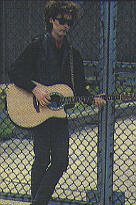 One of the very first
underground pop labels were the Glasgow based Postcard label. One of their
bands were Aztec Camera, who were in reality Roddy Frame (Picture
left). He debuted with the album "High Land Hard Rain", a wonderful album that was
IMO the best debut album that has ever been released. After that he never quite
managed to follow it, although "Dreamland" from 1993 was a great album. The Postcard
label also had some other great pop artists, such as Orange Juice (led by now
succesful solo artist Edwyn Collins) and Paul Haig
One of the very first
underground pop labels were the Glasgow based Postcard label. One of their
bands were Aztec Camera, who were in reality Roddy Frame (Picture
left). He debuted with the album "High Land Hard Rain", a wonderful album that was
IMO the best debut album that has ever been released. After that he never quite
managed to follow it, although "Dreamland" from 1993 was a great album. The Postcard
label also had some other great pop artists, such as Orange Juice (led by now
succesful solo artist Edwyn Collins) and Paul Haig
 Even more important than what happened on
Postcard was XTC (picture right). This innovative and eccentric, still highly
poppy and melodic band started out as some sort of New Wave/Power Pop outfit, then
changed into a more "sophisticated" pop style. They were inspired by late 60s
psychedelic pop. On their later albums they have dropped their original low fi
profile to come up with possibly an even better sound. "Skylarking" from 1986 is IMO
one of the best albums ever made.
Even more important than what happened on
Postcard was XTC (picture right). This innovative and eccentric, still highly
poppy and melodic band started out as some sort of New Wave/Power Pop outfit, then
changed into a more "sophisticated" pop style. They were inspired by late 60s
psychedelic pop. On their later albums they have dropped their original low fi
profile to come up with possibly an even better sound. "Skylarking" from 1986 is IMO
one of the best albums ever made.
Two other important bands/solo projects just had to be mentioned. Scritti
Politti in reality soon turned out to be Green Gartside using a band name.
He made some interesting reggae/jazz funk inspired music and "Cupid & Psyche"
from 1985 contained a lot of great tracks including the hits "The Word Girl" and
"Perfect Way". The latter was covered by Miles Davis, which should be seen as a great
honour. Possibly more of a band than Scritti Politti was Prefab Sprout
although Paddy McAllon was the lead singer, songwriter and undisputed leader.
Their records are harmonically very advanced, but still highly catchy. Their
"Jordan...The Comeback" from 1990 is a great concept album that in lots of fans'
opinion represents the highlight of their career.
 Down under, in Te Awamutu, New Zealand,
Split Enz (picture left) was started in the early 70s. After making some truly
quirky prog rock inspired records during the 70s they turned into a more Power
Pop/New Romantics inspired sound. The band was led by brothers Tim and Neil
Finn, and any of their early 80s albums are worth checking out for pop fans. Big
brother Tim left for a solo career in 1984, and after one more album Neil disbanded
the group to form Crowded House
Down under, in Te Awamutu, New Zealand,
Split Enz (picture left) was started in the early 70s. After making some truly
quirky prog rock inspired records during the 70s they turned into a more Power
Pop/New Romantics inspired sound. The band was led by brothers Tim and Neil
Finn, and any of their early 80s albums are worth checking out for pop fans. Big
brother Tim left for a solo career in 1984, and after one more album Neil disbanded
the group to form Crowded House
Other important "sophisticated underground pop artists" of the 80s were Thomas
Dolby (who also produced Prefab Sprout), The black Nile, The The
and Danny Wilson among others.
Ex-Japan singer David Sylvian could also possibly be put in this category
except he is a lot more experimental than a lot of pop pundits would probably
swallow.
80s Power pop
The US Power Pop movement was somewhat unfashionable during the 80s, and the best
American pop songs you could find on the hitlists were possibly those by girl groups
such as The Go Gos and The Bangles.
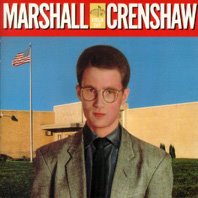 Still this didn't mean that good American
(Power) pop didn't exist during the 80s. You just had to dig a bit down into the
underground to find it. Great US Power pop was still done by artists such as
Marshall Crenshaw(picture right),The Spongetones, Phil Seymour
and The Romantics.
Still this didn't mean that good American
(Power) pop didn't exist during the 80s. You just had to dig a bit down into the
underground to find it. Great US Power pop was still done by artists such as
Marshall Crenshaw(picture right),The Spongetones, Phil Seymour
and The Romantics.
Some AOR-type bands also did great pop records, most important of which were The
Cars. Another 80s AOR artist that some pop pundits may like is Australian Rick
Springfield.
British Indie
Indie originally means "independent", which means the music was released on
independent labels. Still "indie" since the mid-80s also have been used to describe a
particular type of music, mainly British guitar based underground pop. While some 80s
indie stuff may be more rock than pop there still were indie groups that did some
good pop tunes. The Smiths, The Cure and Echo & The Bunnymen
are all examples of British 80s indie groups that at times write/wrote great pop
songs.
After some time indie evolved into baggy, which comes of the big clothes
those artists used to wear. Baggy started in Manchester during the late 80s and was
mainly some sort of compromise between indie pop/rock and the new dance music. Baggy
started as a Manchester thing and the leading baggy group were The Stone
Roses. Some baggy artists were heavily into rap and dance, in such a way the
melodic aim disappeared from their music. Still a lot of baggy bands made great pop
music, among those were The Charlatans, The Mock Turtles and the
earliest stuff by Blur.
Some more British indie bands have to be mentioned here, as they all made some
wonderful 60s inspired stuff that pointed towards what was later to become known as
Britpop. Particularly all lovers of good pop should check out The Wonder
Stuff. Their song "Size Of a Cow" is among the great British indie classics. Also
The La¨s and, a little later; Ride made some wonderful melodic pop
songs in an indie style.
Totally "Unfashionable"
At the turn of the decade making melodic quailty pop was just about as "unhip" as
you could possibly get. The "hip" people loved rap and house music, possibly the
least melodic and "poppy" styles of music ever in rock history. Still some people did
exactly what they wanted to without caring too much about what's hip or not.
One of those people was Karl Wallinger. He used to be a member of The
Waterboys, but split early to start his own band World Party. World Party
based their sound mainly on 60s folk rock combined with some British beat and a
little dash of funk, of course all pretty melodic. "Goodbye Jumbo" from 1990 is a
highly recommended album.
Even bigger was Oz band Crowded House. Started by ex-Split Enz-members Neil
Finn and Paul Hester Crowded House made some truly wonderful songs, given truly
tasteful arrangements. All their three last albums are classics, particularly
"Woodface" from 1991, where also big brother Tim Finn guested as band member for a
short time. They split up in 1996, which was pretty sad to their fans. A lot of
people will proably rank Crowded House as the best pop group of the late 80s/early
90s.
A bit similar to Crowded House were US group Jellyfish. Some people would put
them into the Power Pop category, but in that case they were definitely more pop than
power. Most of all Jellyfish was beautiful harmonic pop music.
In the late 80s UK producer/songwriter Ian Brouide finally started making
records on his own. Broudie had been a member of UK Big In Japan together with later
stars such as Bill Drummond (KLF) and Holly Johnson (Frankie Goes To Hollywood), but
in 1989 he released his debut single "Pure" under the name Lighning Seeds. The
music was melodic pop, filled with harmony. It was wonderful and as far from house
music as you could possibly come. Brouide started some sort of underground movement
for melodic pop, and he also discovered some other melodic acts.
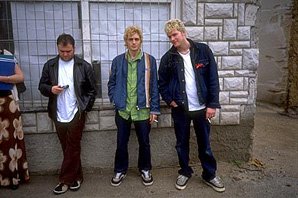 One of those were Dodgy (lef).
Sounding a lot like The Hollies Dodgy wrote songs as strong as the ones
written by Crowded House/Split Enz. They also sang some wonderful backing vocals.
"Staying Out For The Summer" still is among my favourite 90s singles. "Homegrown" and
"Free Peace Sweet" were brilliant albums, and Dodgy is the recent group to
check out!
One of those were Dodgy (lef).
Sounding a lot like The Hollies Dodgy wrote songs as strong as the ones
written by Crowded House/Split Enz. They also sang some wonderful backing vocals.
"Staying Out For The Summer" still is among my favourite 90s singles. "Homegrown" and
"Free Peace Sweet" were brilliant albums, and Dodgy is the recent group to
check out!
With Britpop making good old fashioned pop songs once more fashionable both
Lightning Seeds and Dodgy have had big hits in the UK. (Lightning Seeds even topped
with "Three Lions"). But making "unfashionable" music is still possible, which is
proved by The High Llamas, the brainchild of Sean O'Hagan. Like ELO
originally tried to build their sound on "I Am The Walrus" and "Strawberry Fields
Forever" The High Llamas rather use "Pet Sounds"-era Beach Boys as a musical role
model, which has lead to two great, perfectly produced and highly original
albums.
Britpop explodes
Sometime around 1993-94 the past suddenly became very important indeed for British
indie bands. It seemed the point was to collect the best of British pop history and
turn the whole thing into a style of music that was more British sounding than
anything since British Beat.
Although the mentioned British Beat has been important the first big Britpop band
took most of their inspiration from 70s glam rock. Suede were "the next big
thing" in 1993, and their self titled debut album got rave reviews all over in
British newspapers. For "poppers" their 1996 album "Coming Up" is probably the best
Suede album though.
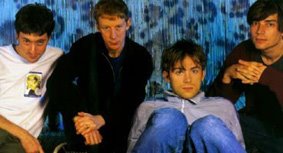
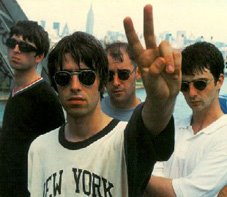
Shortly after Suede Blur(left) were kings of British indie pop. When they
released "Parklife" in 1994 they also broke through to a wider audience than most
British indie bands would normally do. "Parklife" was an album that draw inspiration
from almost the entire British pop history, but particularly from The Kinks. . That
same year Oasis (right) also released their debut album "Definitely Maybe".
Oasis were(and still are) led by two brothers, singer Liam and songwriter
Noel Gallagher. They often spoke to the press about how much they love The
Beatles, but they also spoke about how much they hated Blur, which led to some kind
of "band war".
The autumn after the two groups released a single on the same day. Blur debuted at
UK#1 with "Country House", while Oasis debuted (and stalled) at UK#2 with "Roll With
It". Thus Blur won the first round of the "band war" that had meant a lot of
important publicity for both of them. Later Oasis released "Wonderwall", a much
bigger worldwide hit than Blur had ever had (including huge US sales) and it seemed
that while Blur won the UK band war Oasis had won the US thing.
When Pulp also became quite huge that autumn the press decided a name for the
style, and that's when Britpop was born. The Britpop age was a wonderful time
for pop fans, because it meant that once more melodic pop music was hip. Records by
artists such as Kula Shaker, Ocean Colour Scene, Gene, The
blacktones, Sleeper and Supernaturals meant reason to be happy once
more for most pop pundits, at least us in European countries where most of those
wonderful British records were released.
One group that deserves a special mention here is Super Furry Animals. This
Welch group has developed a somewhat more experimental and psychedelic sound than the
other bands, which still means they often are even better than the others. Their
recent concept album "Radioator" is better than most other Britpop albums ever
released.
Power Pop returns
At a time when retro was dominating the British charts before or since the same
retro/melody/pop thing had to move to the US, and it did in the mid-90s, by once more
bringing Power Pop up from the underground. The new generation US power poppers
partly based their sound on typical 90s grunge-like ideals, but the melodies and
harmonies were the same wonderful ones.
 Among the main names in 90s American
Power Pop are Lemonheads, Gigolo Aunts, Red Kross,
Posies, Wondermints and Matthew Sweet (right). Matthew Sweet has
been making records since the mid-80s, but it's only recently he is being discovered
for real. His recent "black Sky On Mars" album has received rave reviews just about
everywhere, and he is celebrated as some kind of "King of 90s Power Pop".
Among the main names in 90s American
Power Pop are Lemonheads, Gigolo Aunts, Red Kross,
Posies, Wondermints and Matthew Sweet (right). Matthew Sweet has
been making records since the mid-80s, but it's only recently he is being discovered
for real. His recent "black Sky On Mars" album has received rave reviews just about
everywhere, and he is celebrated as some kind of "King of 90s Power Pop".
The recent success of Power Pop has also led to labels searching for bands to
promote and turn into huge stars. It seems that Elektra found one of those when they
signed Third Eye Blind, a grunge-inspired Western Power Pop band, and thanks
to the commercial success of singles such as "Semi Charmed Life" they may well be
labelled the Knack of the 90s.
Still also when it comes to Power Pop the Brits are at the time probably even better
than The Americans. Power Pop veterans on the British scene are Teenage
Fanclub. Their lojal fanbase has grown bigger and bigger for each album, and this
year's "Song From Northern Britian" has to some extent led to them getting some of
the kind of success they long since deserved. Those who know their older work know
that "Grand Prix" is possibly even better.
The most recent addition to the UK Power Pop scene are Silver Sun. With hard
fuzz guitars, Beach Boys-like vocal harmonies and strong songs they have made on of
the better records of 1997 with their self titled debut album.
And this means we are at the end. We are now talking about today's music. Let me
therefore add that besides Power Pop/Britpop Ben Folds Five is an American
band worth checking out. Radiohead's "OK Computer" probably also appeals to
pop pundits the way it has appealed to surprisingly many music fans around the world.
By adding their "The Bends" from 1995 was also a wonderful album I simply stop here.
What a wonderful world of pop it is?!!!!!
Disclaimer

